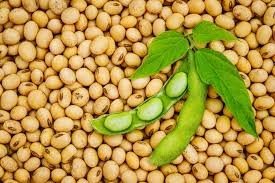Soy Bean - Curse or Solution?
The interest in writing this article was sparked by a few of our recent course participants, who drank soy milk regularly and also by people we know, who avoid soy milk because of the danger of the soy being genetically modified.
Our article uses the following books for reference: “Invitation to a banquet - The story of Chinese Food” by Fuchsia Dunlop and Paul Pitchford’s “Healing with Whole Foods”.
History
Many believe that the soybean plant was first domesticated in central China as early as 1000BC and the use of the soy bean has helped to shape the distinctive Chinese landscape and became part of the fabric of China in both an environmental and gastronomic sense. The soy bean is often called the “beef” of China, due to its extensive use and high protein content (38%).
“Instead of cultivating acres of soy beans to feed to herds of pasturing cows to produce milk for human consumption, as we do in the modern west, they cut out the bovine middleman, transforming the bean itself into milk and cheese-like tofu.” (F Dunlop, page 118)
It was the radical innovations of fermenting soybeans that transformed not only the Chinese diet, but that of Korea and Japan too. The yellow and black soy beans are only digestible when they are fermented, while the young green beans can be eaten cooked.
“The fermentation process eliminates the beans’ trypsin-inhibiting effect.” (P. Pitchford, p 510)
“Soy offers the same sort of nutrition as dairy products, but more economically. It contains twice as much protein of any other legume and all the amino acids essential form human health, in the right proportions for absorption by our bodies.” (F. Dunlop, p 108)
Foods made from soy
Soy beans are used to make tofu with coagulated soy bean milk. It might be that nomadic settlers, deprived of easy access to their traditional dairy foods, invented tofu as substitute for cheese. Types of tofu: Silken, plain white, slabs of tofu as firm as Swiss cheese, deep fried tofu, tofu leathers, frozen tofu, moulded and fermented tofu etc. Soy milk seems to taste similar to cow’s milk, with its creamy consistency. You can’t make butter form soy milk but curds.
Soy Sauce
To the west soy beans were first introduced as soy sauce. To make the soy sauce the yellow or black soy beans are soaked, often mixed with wheat flour, Aspergillus oryzae and also salt and water. They are filled into clay jars and left to ferment and mature. The bean proteins are broken down into delicious amino acids, their oils into fatty acids and their starches into sugars. Before sale, soy sauce is normally pasteurized to arrest its fermentation.
Nowadays we can also buy gluten free soy sauce. When the fermentation is complete, the liquid soy sauce is strained off from the solid beans.
Soy sauce evolved out of a tradition of thick fermented sauces known as Jiang which at the time where more side dishes rather than a flavouring or seasoning agent like nowadays. The rich, savoury, almost meaty tastes could make a largely vegetarian meal palatable. Douchi, another basic component of Chinese Food are the fermented black soy beans used to make mapo tofu and black bean sauces.
What is the problem with soy?
One of the major uses of soybeans globally is as livestock feed, predominantly in the form of soybean meal. In Europe soybean meal provides 60% of the protein to feed livestock, in the US 70% of soybean production is for animal feed (Source Wikipedia). Soy beans are also used for biofuels and industrial oils.
Whereas in China, Japan, Vietnam and Korea soybean products are part of the standard diet. The way soy is grown in the West (mainly for oil and animal feed) has little to do with the way it has been used for thousands of years in East Asia.
Until recently most people in the West regarded soy products like tofu as dull and poor food substitute for meat that was only tolerable for vegetarians., but the environmental crisis we are in and the need to reduce animal protein intake has led to soy products like tofu made more acceptable and is often seen as the only source of protein for vegans. But soy’s reputation in the West has been tainted by its association with clearing the Amazon rainforest for growing vast monocrops of GMO beans.
Soy in the culinary world
Tofu originally entered western diets mostly as a substitute protein for vegetarians and vegans, but that has changed. Fuchsia Dunlop mentions a tasting course called ‘soy culture’ by Ferran Adria, the Catalan chef of El Bulli from 2009 that includes “beansprouts,, soymilk, fermented tofu, soft tofu, crunchy deep-fried soy beans, slimy natto, soft cooked soy beans, soya oil, soymilk ice cream, two kinds of miso, tofu skin and spherified soy sauce”.(F. Dunlop, p 122)
It may be time to bring soy into the Western diet, our diet, as a highly nutritious and very versatile food, grown organically without genetic engineering.


